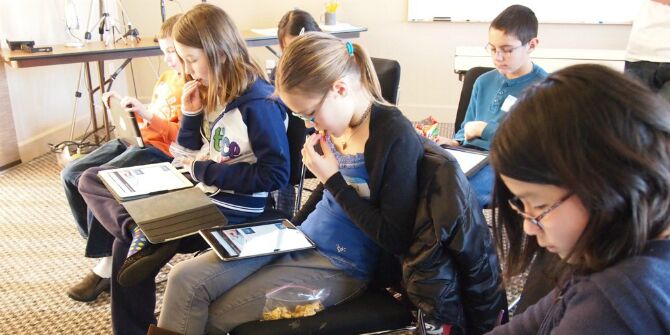 As for all EU member states, the UK has until May 2018 to incorporate the General Data Protection Regulation (GDPR) into British law. Article 8 states that, unless member states decide otherwise, children under the age of 16 years old will require parental permission to use “information society services”, which refers to most online resources. Most provisions of the GDPR are to improve personal data protections for the general public. Some provisions specifically concern additional protections for children, given their supposed lower levels of media literacy. Sonia Livingstone, LSE and Kjartan Ólafsson, University of Akureyri, present their analysis of Ofcom data to explore whether this age limit makes sense. For a version of the report with footnotes that offer more detail on data and methodology, please see here.
As for all EU member states, the UK has until May 2018 to incorporate the General Data Protection Regulation (GDPR) into British law. Article 8 states that, unless member states decide otherwise, children under the age of 16 years old will require parental permission to use “information society services”, which refers to most online resources. Most provisions of the GDPR are to improve personal data protections for the general public. Some provisions specifically concern additional protections for children, given their supposed lower levels of media literacy. Sonia Livingstone, LSE and Kjartan Ólafsson, University of Akureyri, present their analysis of Ofcom data to explore whether this age limit makes sense. For a version of the report with footnotes that offer more detail on data and methodology, please see here.
At present, in both the UK and European debates over the GDPR, little or no evidence has been cited regarding children’s need for protection or, indeed, the ability of their parents to protect them. This short report examines whether and how age makes a difference to levels of media literacy, particularly commercial (or advertising) literacy which, it has long been theorised, increases in stages through childhood and early adolescence. We take note of the International Chamber of Commerce’s recent reiteration of its commitment to protecting under 13s from undue commercial pressures (see also the US’s COPPA), and of recent European research showing that children are vulnerable to such pressures.
New analysis based on Ofcom’s data on media uses and attitudes
To guide the UK in making this decision, we have conducted an exploratory analysis of the following survey data:
- Ofcom’s 2016 children’s and parents’ media use and attitudes dataset (children 5-15; adults with a child 3-15 living at home for whom they have parental responsibility)
- Ofcom’s 2015 adults’ media use and attitudes dataset (ages 16+)
We have looked at questions that concern media literacy in relation to the internet, focusing on commercial and critical dimensions of literacy.
Indicators of commercial literacy across the age range
As the following graph shows:
- Children’s commercial literacy increases fairly steadily from age 8 to young adulthood. Specifically, they become gradually less likely to think that all information on news media sites is true (blue line) and more likely to know that sponsored results on Google are adverts that have paid to be there.
- There is a noticeable improvement in commercial literacy from 13 to 16. This could support the intention behind GDPR article 8 that those below 16 merit parental protection. Or it might reflect the benefits of the UK computing curriculum, so that if UK schools children taught commercial literacy education earlier, 13 year olds could learn that older teens learn, obviating the need for parental protection for younger teens.

Note that Ofcom also asked whether children thought all the information on social media sites was true, but only 2% of 8-11 year olds and 4% of 12-15 year olds agreed with this – fewer than in 2015, and fewer than adult respondents from the 2015 survey too.
In relation to trusting Google search results, the graph below shows the results for search engine users aged 8-21. This suggests that:
- With increasing age, children gain the commercial literacy to realise that some but not all search engine results can be trusted. However, there is no strong increase in understanding through the early teens, the main gain being among younger children.
- On this basis, one might conclude that 13 year olds are almost as literate as 16 year olds (it being younger internet users who lack commercial literacy).
 The next graph shows the same data across the adult age range, revealing that:
The next graph shows the same data across the adult age range, revealing that:
- Both younger and older people have somewhat lower levels of critical digital literacy compared with those aged around 30 to 60.
- The gains made through adolescence continue up to the late 20s, with no obvious cut-off in commercial literacy terms at the age of 16.
- Also noteworthy is the finding that around one third of adult internet users believe that Google results can all be trusted. This suggests the need for greater transparency from search engines and/or greater digital literacy education for all adults, not just children.
Indicators of commercial literacy for 12-15 year olds
Ofcom asks children and adults if they know how media are funded, as an indicator of commercial literacy. The following graph shows answers for YouTube and Google:
- This graph suggests a marked increase in children’s commercial literacy from the age of 12 to 15 years old.
- Interestingly, the answers for Google suggest that 14 and 15 year olds have greater literacy than older teenagers and young adults.
 It is worth noting that combining children’s data with data from adults across the age range gives little confidence that commercial literacy continues to increase with age, or that parents have the necessary knowledge to protect their children. Indeed, the majority of UK adults (including many parents) do not know how Google is funded.
It is worth noting that combining children’s data with data from adults across the age range gives little confidence that commercial literacy continues to increase with age, or that parents have the necessary knowledge to protect their children. Indeed, the majority of UK adults (including many parents) do not know how Google is funded.
Last, through questions asked only of 12-15 year olds, the Ofcom data suggests that children do gain greater commercial literacy by the age of 15 compared with what they know at 12 or 13 years old, as shown below. The graph below shows that:
- From 12 to 15 children’s commercial literacy rises considerably, as they learn that advertising is personally targeted (blue line) and that vloggers are paid to promote products (orange line).
- The graph also shows, albeit less clearly, that from 12 to 15 children become more likely to value getting ‘likes’ online and more likely to provide personal data in order to gain ‘followers’.
- Thus, it is by no means clear that a critical understanding of the digital environment results in cautious behaviour regarding personal data protection.
The intent of the GDPR is to reduce children’s vulnerability to commercial and data risks. Broadly speaking, teenagers’ commercial media literacy increases from the ages of 12 to 15 (although not necessarily much more thereafter). This suggests that requiring parental consent up to the age of 16 would have benefits in terms of children’s privacy and data protection.
- In other words, since the evidence suggests that children progressively gain in media literacy with age, experience and maturity, it can be concluded that they should rightfully be protected by parents and regulation when younger.
- However, as children grow older, setting rules that they are not allowed to be on social networking sites becomes less effective. The requirement for parental consent could, therefore, result both in increased deception and evasion on teenagers’ part and, possibly, inequalities in who can or cannot obtain parental consent.
- Alternatively, it could be argued that the present findings show the benefit of school-based media literacy education enjoyed by older teens and, if extended more systematically to younger children, this would serve to protect their privacy from commercial exploitation even without parental oversight.
- In short, the observed gap in commercial literacy between 13 and 16 year olds could be filled by more and better media education in school for all children, certainly from 11 years old (ready for 13), if not earlier, so they learn the critical skills needed to protect themselves in the commercial environment.
- Also likely to prove effective would be fairer dealing with children by companies so that they understand better, from a younger age, how online services are funded, how their data are treated, and what choices and forms of redress are available to them.
Looked at this way, the present data measure the size of the gap to be filled, to bring 13 year olds up to the knowledge of 16 year olds (and, ideally, to bring up the knowledge of the entire population from present insufficient levels of knowledge about the commercial environment and the conditions of online data exploitation).
If the UK selects 16 rather than 13 as the age for parental consent of children’s internet use, to the likely dismay of teenagers, also important would be the likely costs in teenagers’ reduced opportunities for creative, educational, civic and communicative activities online.
As ever, children’s rights to protection online must be considered in the light of their provision and participation rights, reconciling potential conflicts of rights and seeking their best interests overall.
This post gives the views of the author and does not represent the position of the LSE Media Policy Project blog, nor of the London School of Economics and Political Science. For a version of the report with footnotes that offer more detail on data and methodology, please see here.








2 Comments